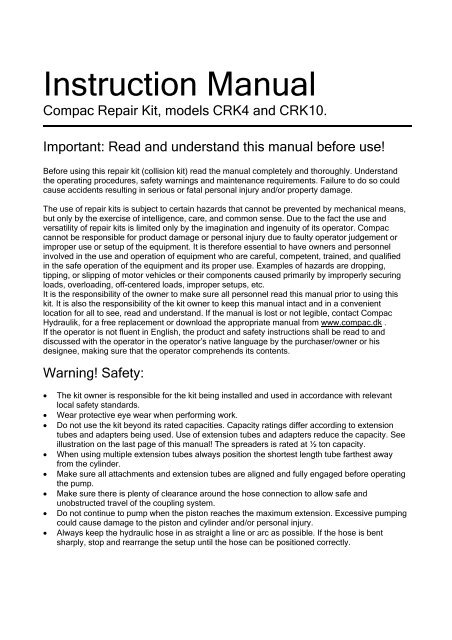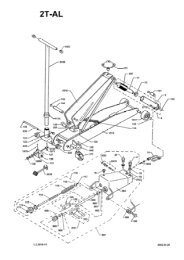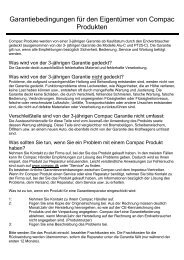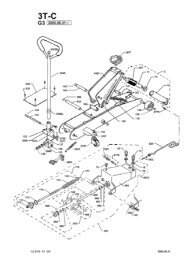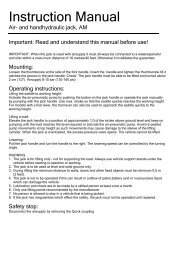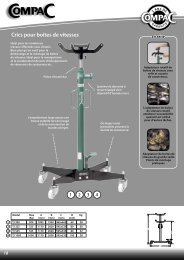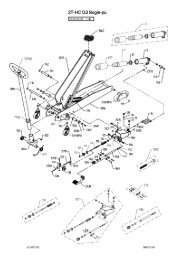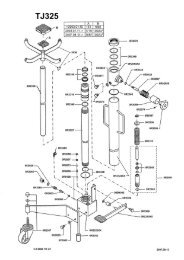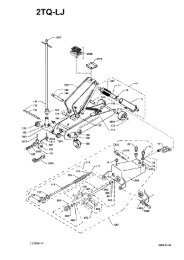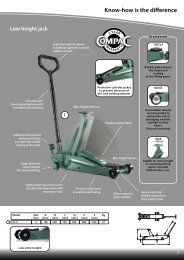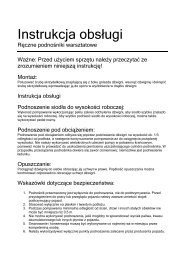Instruction Manual - CompaC
Instruction Manual - CompaC
Instruction Manual - CompaC
Create successful ePaper yourself
Turn your PDF publications into a flip-book with our unique Google optimized e-Paper software.
<strong>Instruction</strong> <strong>Manual</strong><br />
Compac Repair Kit, models CRK4 and CRK10.<br />
Important: Read and understand this manual before use!<br />
Before using this repair kit (collision kit) read the manual completely and thoroughly. Understand<br />
the operating procedures, safety warnings and maintenance requirements. Failure to do so could<br />
cause accidents resulting in serious or fatal personal injury and/or property damage.<br />
The use of repair kits is subject to certain hazards that cannot be prevented by mechanical means,<br />
but only by the exercise of intelligence, care, and common sense. Due to the fact the use and<br />
versatility of repair kits is limited only by the imagination and ingenuity of its operator. Compac<br />
cannot be responsible for product damage or personal injury due to faulty operator judgement or<br />
improper use or setup of the equipment. It is therefore essential to have owners and personnel<br />
involved in the use and operation of equipment who are careful, competent, trained, and qualified<br />
in the safe operation of the equipment and its proper use. Examples of hazards are dropping,<br />
tipping, or slipping of motor vehicles or their components caused primarily by improperly securing<br />
loads, overloading, off-centered loads, improper setups, etc.<br />
It is the responsibility of the owner to make sure all personnel read this manual prior to using this<br />
kit. It is also the responsibility of the kit owner to keep this manual intact and in a convenient<br />
location for all to see, read and understand. If the manual is lost or not legible, contact Compac<br />
Hydraulik, for a free replacement or download the appropriate manual from www.compac.dk .<br />
If the operator is not fluent in English, the product and safety instructions shall be read to and<br />
discussed with the operator in the operator’s native language by the purchaser/owner or his<br />
designee, making sure that the operator comprehends its contents.<br />
Warning! Safety:<br />
• The kit owner is responsible for the kit being installed and used in accordance with relevant<br />
local safety standards.<br />
• Wear protective eye wear when performing work.<br />
• Do not use the kit beyond its rated capacities. Capacity ratings differ according to extension<br />
tubes and adapters being used. Use of extension tubes and adapters reduce the capacity. See<br />
illustration on the last page of this manual! The spreaders is rated at ½ ton capacity.<br />
• When using multiple extension tubes always position the shortest length tube farthest away<br />
from the cylinder.<br />
• Make sure all attachments and extension tubes are aligned and fully engaged before operating<br />
the pump.<br />
• Make sure there is plenty of clearance around the hose connection to allow safe and<br />
unobstructed travel of the coupling system.<br />
• Do not continue to pump when the piston reaches the maximum extension. Excessive pumping<br />
could cause damage to the piston and cylinder and/or personal injury.<br />
• Always keep the hydraulic hose in as straight a line or arc as possible. If the hose is bent<br />
sharply, stop and rearrange the setup until the hose can be positioned correctly.
• Be careful not to pinch the hydraulic hose and avoid dropping heavy objects onto the hose. If<br />
the hose leaks fluid while under pressure, the piston will retract. If the hose is cut, loss of<br />
pressure will be immediate.<br />
• Never use the hydraulic hose as a handle to carry the pump and cylinder assembly.<br />
• Make sure the setup is stable and secure before performing any work. Always operate the<br />
pump slowly and carefully, keeping an eye on the operation to be sure the setup is doing its<br />
intended job correctly and that the load is safely centered or locked in position.<br />
• Use only Compac components rated specifically for the Compac repair kit used.<br />
• Do not alter or modify any Compac repair kit component.<br />
• Some setup components are rated less than the capacity of the pump and cylinder!<br />
Installation:<br />
1. Connect the flexible hose to the pump and cylinder. It is not necessary to use pliers to tighten<br />
the threaded collar.<br />
2. There are two different methods of connecting extension tubes and adopters. “Quick-Lock”<br />
connections where extension tubes, adapters and piston slip fit together. Also threaded<br />
connections are used. Make sure all “Quick-Lock” and threaded connections are fully engaged<br />
before using.<br />
3. There is a vent on some pumps. The vent screw is located in the top rear end of the pump’s<br />
reservoir. The vent screw must be opened by turning it in a counter clockwise direction two full<br />
turns before operating the pump.<br />
4. Sometimes air gets trapped in the hydraulic system when the hose is first hooked up to the<br />
cylinder. An air bound hydraulic system feels spongy when pumped and sometimes the pump<br />
will not pump in full incremental pump strokes.<br />
Trouble shooting:<br />
Purging air from the hydraulic system:<br />
1. Open the release valve in the side of the hydraulic pump by turning it two full turns in a counter<br />
clockwise direction.<br />
2. Activate the pump handle up and down about 15 times.<br />
3. Close the release valve by turning it in a clockwise direction until tight.<br />
4. Activate the pump handle until the piston is extended all the way out.<br />
5. If the condition seems better but is still detectable, repeat steps “1” through “4” until all air is<br />
purged from the system.
Operating instruction:<br />
Compac repair kits provide the user with an effective method to accomplish the following basic<br />
tasks with the pilling, clamping, spreading, pushing, lifting, pressing and straightening. The basic kit<br />
consists of a hand operated portable pump, hydraulic hose, cylinder, extension tubes and adapters.<br />
The wide range of setup combinations for specific job requirements makes it impossible to<br />
document every conceivable application.<br />
1. Study the type of work to be done and determine the components (extension tubes and<br />
adapters) needed for the setup.<br />
2. Make sure all threaded components are free of dirt, dust, nicks, cuts, etc. Always use the<br />
threaded protector ring on all cylinders when the threads are not being used.<br />
3. The pump can be operated in a horizontal position or in a vertical position with the hose<br />
pointing down. Cylinders can be used in any position provide the setup is safe and secure.<br />
4. Once the kit components are properly connected and are positioned in the setup, turn the<br />
pump’s release valve in a clockwise direction until hand tightened. Slowly operate the pump<br />
handle so the piston is extended to meet the load. At the same time make sure extension tubes<br />
and adapters (in-line or off-center) are stable and secure. If the setup becomes unstable, turn<br />
the pump’s release valve in a counter clockwise direction to remove the cylinder pressure and<br />
then adjust or change the setup accordingly. NOTE: All cylinders have return springs that return<br />
them to their retracted positions when the pump’s release valve is opened. The pump is<br />
equipped with an overload system that will send the oil back into the pump reservoir if the<br />
system is overloaded. Stop pumping and release the load if the system is overloaded.<br />
5. After work is completed, turn the pump’s release valve slowly in a counter clockwise direction to<br />
release pressure from the cylinder.<br />
6. IMPORTANT: Make sure the piston is completely retraced before disconnecting the hose from<br />
the cylinder.<br />
7. The air quick disconnect fittings are repeatedly disconnected and exposed to shop or work<br />
place floors that contain dirt or debris. It is important to use the caps properly in the male and<br />
female air quick disconnect fittings immediately after disconnecting them to prevent dirt and<br />
debris form entering the hydraulic system.<br />
Maintenance and service:<br />
1. Always store the repair kit in its case in a well protected area where it will not be exposed to<br />
inclement weather, corrosive air, abrasive dust, or any other harmful elements. The repair kit<br />
must be cleaned of water, snow, sand, or grit before using.<br />
2. A thin coat of general purpose grease must be applied to the external threads of all applicable<br />
components. General purpose grease must be applied to the pump’s pump linkage, not the<br />
pump piston.<br />
3. IMPORTANT: In order to prevent seal damage and hydraulic failure, never use alcohol, brake<br />
fluid, transmission oil, etc in the pump. Use hydraulic oil AW ISO 32 only.<br />
4. Every kit owner is responsible for keeping the kit label clean and readable. Use a mild soap<br />
solution to wash external surfaces of the kit but not any moving hydraulic components.<br />
5. Do not attempt to make any repairs unless you are a qualified repair person that is familiar with<br />
the equipment.
Repair Service:<br />
If your Compac product requires service or repair, contact Compac for the location of the nearest<br />
Compac authorized service center:<br />
Compac Hydraulik A/S<br />
Strandhusevej 42<br />
7130 Juelsminde<br />
Denmark<br />
Tlf.: +45 75 69 37 22<br />
Fax.: +45 75 69 54 18<br />
www.compac.dk<br />
It will be necessary to provide the Compac authorized service center with a copy of the bill of sale if<br />
requesting warranty repair. Please see www.compac.dk for complete information on warranty<br />
processes, terms and conditions.<br />
Decommissioning:<br />
Please handle the oil and repair kit in accordance with the local environment requirements. Do not<br />
through the oil or the repair kit away with normal waste.
Illustration of capacities:<br />
Please see the following illustration for further information:<br />
The shortest extension should always be fitted furthest away from the piston when using more<br />
extensions at the same time.<br />
0 2 4<br />
0 2 4<br />
0<br />
x<br />
0<br />
x<br />
Forlængere<br />
Extensions<br />
Verlängerungen<br />
Tube<br />
Tubo<br />
Buis<br />
Förlängare<br />
труба<br />
1<br />
x<br />
2<br />
x<br />
3<br />
x<br />
Forlængere<br />
Extensions<br />
Verlängerungen<br />
Tube<br />
Tubo<br />
Buis<br />
Förlängare<br />
труба<br />
1<br />
x<br />
2<br />
x<br />
3<br />
x<br />
4<br />
x<br />
4<br />
x<br />
CRK 4<br />
Max, maxi (Kg)<br />
4.000<br />
2.000<br />
2.000<br />
1.000<br />
1.000<br />
CRK 4<br />
1.000<br />
500<br />
250<br />
250<br />
CRK 10<br />
Max, maxi (Kg)<br />
2.000<br />
10.000<br />
5.000<br />
5.000<br />
2.500<br />
2.500<br />
CRK 10<br />
5.000<br />
2.500<br />
1250<br />
600<br />
600


